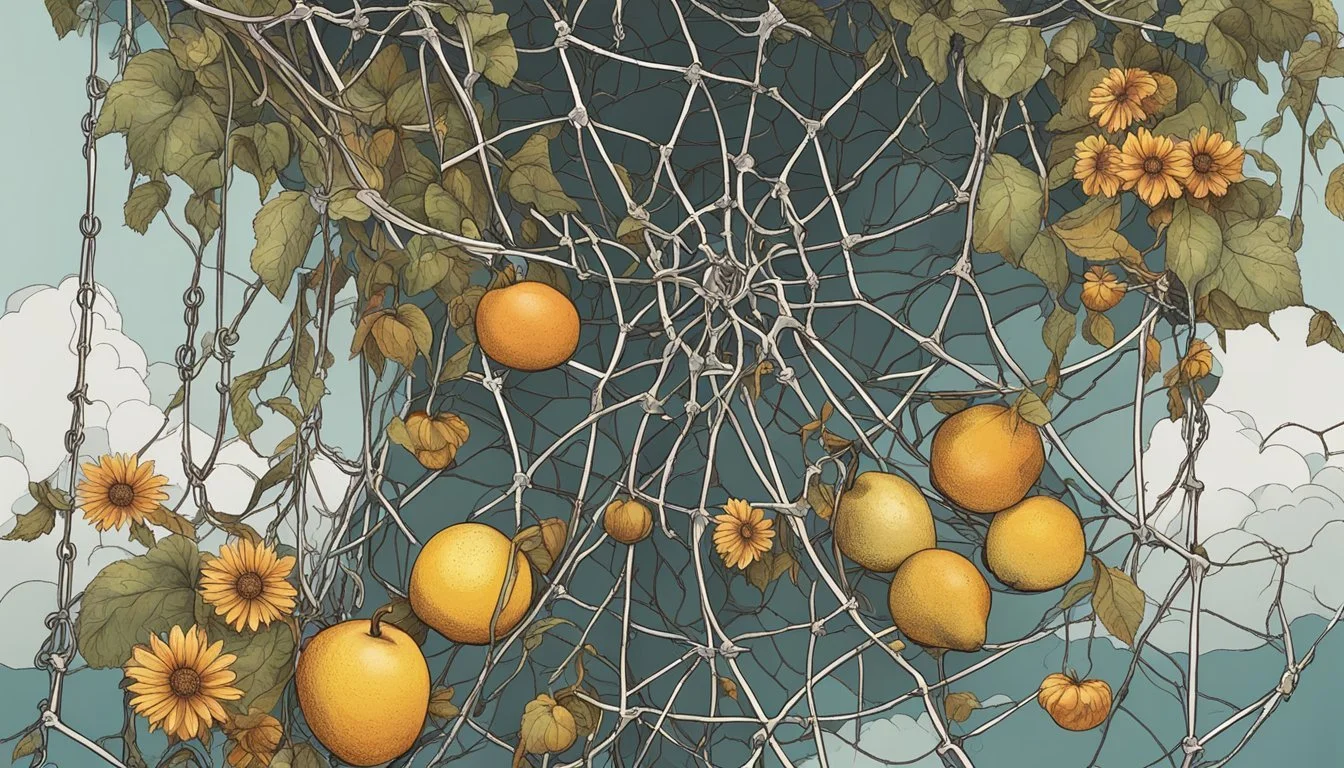Does Dukkah Go Bad?
Understanding Shelf Life and Storage
Dukkah, a Middle Eastern spice blend, is celebrated for its savory and aromatic qualities, making it a staple in various cuisines. Many wonder if this flavorful blend can go bad over time. Yes, dukkah can go bad due to the natural oils in the nuts and seeds becoming rancid.
Stored properly in an airtight container in a cool, dark place, dukkah can retain its quality for several months. Oxidation and exposure to heat and light speed up the degradation process, affecting the taste and aroma. To ensure the best experience, always check for changes in smell and flavor before using dukkah in your recipes.
Understanding Dukkha in Buddhism
Dukkha, often translated as suffering or unsatisfactoriness, is a central concept in Buddhism. It underpins much of the Buddha's teachings, emphasizing the transient and unsatisfactory nature of life due to its inherent impermanence and constant change.
Definition and Origins
Dukkha is a Pali term that is commonly translated as suffering, but its full meaning encompasses a range of experiences from minor discomfort to profound grief and despair. The word originates from the ancient language of Theravada Buddhist scriptures. While dukkha is often equated with suffering, it more accurately represents dissatisfaction and the inherent unsatisfactoriness of life. The Buddha taught that dukkha is an integral part of human existence, affecting all aspects of life.
The First Noble Truth
The First Noble Truth states that life is imbued with dukkha. This is often misunderstood as life being exclusively suffering; however, the Buddha intended to convey that all forms of pleasure and happiness are temporary and inevitably lead to dissatisfaction. Life's constant changes contribute to this unsatisfactory nature. This truth is foundational in Buddhist teachings, urging practitioners to recognize the presence of dukkha in their lives and understand it deeply as part of their spiritual journey.
Forms of Dukkha
Dukkha manifests in various forms. There is the dukkha of ordinary suffering including physical pain, illness, and emotional distress like grief and despair. Another form is the dukkha produced by change, reflecting the sadness and grief that arise from the impermanence of pleasurable experiences. The third form is dukkha arising from conditioned states, related to the five aggregates (form, sensation, perception, mental formations, and consciousness). Recognizing these forms helps individuals navigate the complexities of existence.
Concept of Impermanence (Anicca)
Anicca, or impermanence, is another crucial concept in understanding dukkha. It highlights that all things, including our thoughts, feelings, and conditions, are temporary and constantly changing. This impermanence leads to dukkha, as attachments to transient things result in mental pain and distress when they inevitably change or disappear. The recognition of anicca encourages a detachment from these fleeting experiences, aligning with the Buddhist path towards liberation from suffering.
The Interconnectedness of Dukkha
The concept of dukkha, or suffering, is deeply interconnected with various facets of human existence. Particularly, craving and attachment lead to suffering, aversion compounds discomfort, and the idea of non-self (anatta) challenges our attachment to ego.
Craving and Attachment
Craving, or tanha, fundamentally leads to suffering. When individuals desire something intensely, they often become attached to their desires. This attachment, or upadana, can cause greed and anxiety as they strive to attain or maintain what they crave.
The cycle of craving and clinging not only heightens stress but also perpetuates a conditioned state that breeds further unsatisfactoriness. Awareness of this dynamic is crucial for reducing the suffering it produces. Efforts to achieve cessation involve recognizing and mitigating these cravings, thereby easing the discomfort they induce.
Aversion and Avoidance
Aversion, the other side of craving, also generates suffering. Trying to avoid or escape unpleasant situations often leads to lamentation and additional stress. People naturally develop aversions to pain, aging, and change.
This aversive behavior results in avoidance tactics that fail to address the root causes of discomfort. By fostering compassion and mindfulness, one can better handle aversions, easing both mental and physical distress. Developing awareness of our aversive responses can break the cycle of avoidance, helping individuals to confront and reduce their suffering.
Understanding Anatta (Non-Self)
The concept of anatta, or non-self, posits that what we consider our "self" is actually a combination of conditioned phenomena, known as sankhara. This challenges the notion of a permanent, unchanging ego.
Recognizing anatta helps diminish attachment to the self, which is a significant source of suffering. Without this attachment, one can more readily accept the constant arising and cessation of experiences without clinging to them. Acknowledging anatta enables a deeper understanding of human existence and alleviates the stress and lamentation tied to ego-based perceptions. This insight plays a crucial role in navigating the complexities of dukkha.
The Path to Overcoming Dukkha
The journey to overcoming dukkha in Buddhism involves practical and ethical guidelines. These include following the Noble Eightfold Path, engaging in specific practices, and cultivating wisdom and compassion.
The Noble Eightfold Path
The Noble Eightfold Path is central to overcoming dukkha. It comprises eight interrelated practices divided into three groups: wisdom, ethical conduct, and mental discipline. Wisdom includes Right View and Right Intention. Ethical Conduct encompasses Right Speech, Right Action, and Right Livelihood. Mental Discipline involves Right Effort, Right Mindfulness, and Right Concentration. Each aspect guides adherents toward a balanced, mindful life that minimizes suffering and promotes spiritual liberation.
Practices Leading to Cessation of Suffering
Several practices aim at reducing and eventually ending dukkha. Meditation, specifically vipassana (insight meditation), helps individuals observe and understand the nature of their thoughts and feelings. Mindfulness practices encourage present-moment awareness and reduce attachment to impermanent things. Additionally, ethical living, including compassion and kindness toward others, directly reduces harmful actions that lead to suffering. These practices collectively foster a lifestyle that detaches from craving and aversion.
The Role of Wisdom and Compassion
Wisdom and compassion are crucial for overcoming dukkha. Wisdom (paññā) involves deep understanding of the Four Noble Truths and the nature of reality, recognizing the impermanence and interconnectedness of all things. Compassion (karuṇā) entails empathy and a desire to alleviate the suffering of others. Together, wisdom and compassion form a balanced approach to life. They enable individuals to make informed, ethical decisions and cultivate a mindset that transcends personal suffering, benefiting both oneself and others.
Cultural and Historical Context
Dukkha, a central concept in Buddhism, refers to the inherent suffering and unsatisfactoriness present in life. This section explores how dukkha is perceived across different Buddhist traditions and the various translations and interpretations.
Dukkha Across Different Buddhist Traditions
Dukkha is elaborated extensively in various Buddhist traditions, each shedding light on its distinct facets. In Theravada Buddhism, dukkha is emphasized in the context of the Four Noble Truths, where suffering is recognized as an inescapable part of human existence. The term appears in ancient texts in Pali and Sanskrit, where it includes both physical pain and existential malaise.
Mahayana Buddhism considers dukkha under the broader perspective of samsara (the cycle of birth and death). Here, suffering manifests through tanha (thirst or desire) that traps beings in a continuous cycle of rebirth. This tradition often delves into more complex aspects of dukkha, exploring mental and emotional suffering linked to the illusion of a permanent self.
Translations and Interpretations
The term dukkha has been translated and interpreted in multiple ways in English and other languages. It is often referred to as "suffering," but this translation may not fully capture its nuanced meaning. Alternatives include "unsatisfactoriness" or "stress," reflecting the broad nature of dukkah’s impact on life.
Early Sanskrit and Pali texts illustrate the depth of dukkha through various forms, such as dukkha-dukkha (suffering due to pain) and viparinama-dukkha (suffering due to change). Each form recognizes how impermanence (aniccha) brings about a state of discontent and discomfort. Over time, scholars and practitioners have provided diverse interpretations aimed at enhancing the understanding of this core concept.
Understanding these varied translations and interpretations helps in grasping the full scope of what the Buddha conveyed in his teachings. This multifaceted approach allows for a richer appreciation of how dukkha is interwoven with other aspects of the Noble Eightfold Path.
Dukkha in Contemporary Society
Dukkha, often translated as suffering or unsatisfactoriness, manifests uniquely in today's fast-paced and interconnected world. From stress at work to emotional disorders, modern life presents new contexts for experiencing and understanding dukkha.
Modern Applications of the Dukkha Concept
In contemporary society, the concept of dukkha can be seen in the relentless pursuit of material wealth and sensory pleasures. Craving for the next promotion, a new gadget, or more social media validation aligns with the traditional idea of dukkha arising from desire.
Many people experience stress and anxiety as they chase these goals, which only leads to more suffering. Unlike physical pain, mental and emotional anguish from unmet expectations can be harder to pinpoint but equally distressing.
Meditative practices and mindfulness, grounded in understanding dukkha, are modern strategies people adopt to cope with stress and find equilibrium in life. These techniques offer the chance to observe thoughts and emotions without attachment, fostering a sense of acceptance and inner peace.
Stress and Suffering in the Modern World
Modern society's emphasis on speed and efficiency contributes significantly to stress levels. Daily life, filled with work pressures and personal responsibilities, exemplifies the Buddhist teaching that "life is suffering."
Sickness, such as cancer, adds another layer of dukkha, highlighting impermanence and the vulnerability of human existence. Physical pain from illness, combined with the emotional impact of a diagnosis, underscores the multifaceted nature of suffering.
The loss of loved ones, job insecurity, and other tragedies magnify emotional anguish and misery. Recognizing dukkha in these experiences encourages the development of compassion and empathy. It provides a framework for understanding and alleviating not only personal distress but also the suffering of others.
Conceptual Understanding and Misconceptions
It's essential to understand the nuanced meanings of dukkha and how misinterpretations can lead to misconceptions about Buddhism and its teachings. This section addresses two common misconceptions: the pessimistic view of dukkha and its relation to the pursuit of happiness.
The Pessimistic Misinterpretation
Many people incorrectly interpret dukkha as a purely pessimistic concept, equating it solely with suffering. This misunderstanding arises primarily from translating dukkha simply as "suffering" in English. While dukkha encompasses suffering, it also refers to a broader concept of dissatisfaction and unsatisfactoriness.
The Buddha's First Noble Truth highlights life's inherent dissatisfaction, not to evoke a sense of hopelessness, but to provide a realistic foundation for spiritual growth. Dukkha acknowledges that pleasure and pain are transient due to anicca (impermanence). Therefore, understanding dukkha in its full context reveals a balanced perspective rather than a pessimistic one.
Dukkha and the Pursuit of Happiness
Another common misconception is the belief that acknowledging dukkha implies rejecting happiness. In reality, Buddhism does not deny the existence of pleasure or sukha (happiness). Instead, it teaches that true happiness is not found in transient, material desires but through overcoming greed, craving, and delusion.
The Buddha's Second Noble Truth identifies craving (tanha) as the origin of dukkha. This craving often leads to ignorance and perpetual dissatisfaction. By recognizing the impermanence of all things, individuals can transcend superficial pleasures and discover a deeper, more enduring sense of peace.
Understanding dukkha in this way encourages a balanced pursuit of well-being, aligning desires with a mindful awareness of life's inherent impermanence and interconnectedness. This deeper comprehension helps dispel the misconception that Buddhism advocates for a life devoid of happiness or pleasure.






